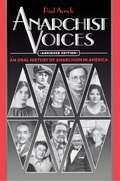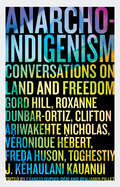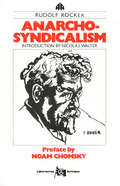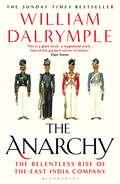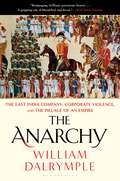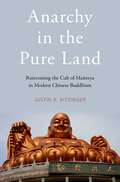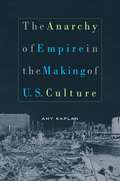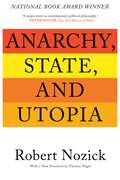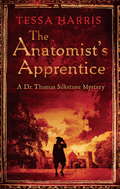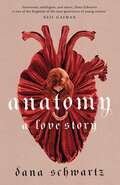- Table View
- List View
Anarchist Voices: An Oral History of Anarchism in America - Abridged paperback Edition
by Paul AvrichThrough his many books on the history of anarchism, Paul Avrich has done much to dispel the public's conception of the anarchists as mere terrorists. In Anarchist Voices, Avrich lets American anarchists speak for themselves. This abridged edition contains fifty-three interviews conducted by Avrich over a period of thirty years, interviews that portray the human dimensions of a movement much maligned by the authorities and contemporary journalists. Most of the interviewees (anarchists as well as their friends and relatives) were active during the heyday of the movement, between the 1880s and the 1930s. They represent all schools of anarchism and include both famous figures and minor ones, previously overlooked by most historians. Their stories provide a wealth of personal detail about such anarchist luminaries as Emma Goldman and Sacco and Vanzetti.
Anarchist Voices: An Oral History of Anarchism in America - Abridged paperback Edition
by Paul AvrichThrough his many books on the history of anarchism, Paul Avrich has done much to dispel the public's conception of the anarchists as mere terrorists. In Anarchist Voices, Avrich lets American anarchists speak for themselves. This abridged edition contains fifty-three interviews conducted by Avrich over a period of thirty years, interviews that portray the human dimensions of a movement much maligned by the authorities and contemporary journalists. Most of the interviewees (anarchists as well as their friends and relatives) were active during the heyday of the movement, between the 1880s and the 1930s. They represent all schools of anarchism and include both famous figures and minor ones, previously overlooked by most historians. Their stories provide a wealth of personal detail about such anarchist luminaries as Emma Goldman and Sacco and Vanzetti.
Anarchistische Uhrmacher in der Schweiz: Mikrohistorische Globalgeschichte zu den Anfängen der anarchistischen Bewegung im 19. Jahrhundert (Histoire #113)
by Florian EitelWarum bekannten sich Uhrmacher im Tal von Saint-Imier in der Schweiz zum Anarchismus? Erklärungen liefert die Perspektive der ›modernen Globalisierung‹: Wie die Weltwirtschaft ging auch der Anarchismus aus globalen Kommunikations-, Transport-, Finanz- und Migrationsflüssen der zweiten Hälfte des 19. Jahrhunderts hervor - allerdings als Alternative zu Nationalismus und Kapitalismus. Mit der Untersuchung von Florian Eitel widmet sich zum ersten Mal seit 40 Jahren eine historische Studie der einflussreichen anarchistischen Juraföderation. Bisher namenlose Mitglieder dieser Organisation treten aus dem Schatten bekannter Revolutionäre wie Michail Alexandrowitsch Bakunin und Pjotr Alexejewitsch Kropotkin. Die mikrohistorische Globalgeschichte analysiert, wie eine noch heute global aktive politische Bewegung entstand und funktionierte.
Anarcho-Indigenism: Conversations on Land and Freedom
by Gord Hill Roxanne Dunbar-Ortiz Clifton Ariwakehte Nicholas Véronique Hébert Freda Huson Toghestiy J. Kēhaulani Kauanui"Anarchists have much to learn from Indigenous struggles for decolonization. [A] thought-provoking collection" Lesley J. Wood, Professor, York University, Toronto"Vigorously affirming anarchism’s plurality, the authors make a powerful case for the reconfiguration of anticolonial struggle" Ruth Kinna, Professor, Loughborough UniversityAs early as the end of the nineteenth century, anarchists such as Peter Kropotkin and Élisée Reclus became interested in Indigenous peoples, many of whom they saw as societies without a state or private property, living a form of communism. Thinkers such as David Graeber and John Holloway have continued this tradition of engagement with the practices of Indigenous societies, while Indigenous activists coined the term ‘anarcho-indigenism’, in reference to a long history of (often imperfect) collaboration between anarchists and Indigenous activists, over land rights and environmental issues, including recent high profile anti-pipeline campaigns.Anarcho-Indigenism is a dialogue between anarchism and Indigenous politics. In interviews, the contributors reveal what Indigenous thought and traditions and anarchism have in common, without denying the scars left by colonialism. They ultimately offer a vision of the world that combines anti-colonialism, feminism, ecology, anti-capitalism and anti-statism.Francis Dupuis-Déri is a Professor of Political Science and a member of the Institut de Recherches et d’études Féministes at the Université du Québec à Montréal. He is the author of several books such as Who’s Afraid of the Black Blocs?. Benjamin Pillet is a translator and community organizer, with a PhD in Political Thought from the Université du Québec à Montréal.
Anarcho-Syndicalism (Pluto Classics)
by Rudolf RockerRudolf Rocker’s classic survey of anarcho-syndicalism was written during the Spanish Civil War to explain to the wider reading public the ideology which inspired the social revolution in Spain. It remains unsurpassed as a general introduction to anarchist thought and an authoritative account of the early history of international anarchism by one of the movement’s leading figures.*BR**BR*The present edition is unique in giving a complete facsimile reproduction of the 1938 edition as well as the corrected transcript of the epilogue to the Indian edition of 1947. It has the addition of a new biographical introduction by Nicolas Walter, in which he quotes from previously unpublished manuscript sources.
Anarcho-Syndicalism: Theory And Practice (Pluto Classics #Vol. 2)
by Rudolf RockerRudolf Rocker’s classic survey of anarcho-syndicalism was written during the Spanish Civil War to explain to the wider reading public the ideology which inspired the social revolution in Spain. It remains unsurpassed as a general introduction to anarchist thought and an authoritative account of the early history of international anarchism by one of the movement’s leading figures.*BR**BR*The present edition is unique in giving a complete facsimile reproduction of the 1938 edition as well as the corrected transcript of the epilogue to the Indian edition of 1947. It has the addition of a new biographical introduction by Nicolas Walter, in which he quotes from previously unpublished manuscript sources.
Anarchy (The Making of England Quartet #3)
by Stewart BinnsAnarchy is the knuckle-whitening third novel in Stewart Binns' The Making of England series. Ruthless brutality, greed and ambition: the AnarchyThe year is 1186, the thirty-second year of the reign of Henry II.Gilbert Foliot, Bishop of London, has lived through long Henry's reign and that of his grandfather, Henry I. He has witnessed the terrifying civil war between Henry II's mother, the Empress Matilda, and her cousin, Stephen; a time so traumatic it becomes known as the Anarchy.The greatest letter writer of the 12th Century, Folio gives an intimate account of one of England's most troubled eras. Central to his account is the life of a knight he first met over fifty years earlier, Harold of Hereford.Harold's life is an intriguing microcosm of the times. Born of noble blood and legendary lineage, he is one of the nine founders of the Knights Templar and a survivor of the fearsome battles of the Crusader States in the Holy Land.Harold is loyal warrior in the cause of the Empress Matilda. On his broad shoulders, Harold carries the legacy of England's past and its dormant hopes for the future.Stewart Binns' Anarchy is a gripping novel in the great tradition of Conn Iggulden and Bernard Cornwell, and is the third in The Making of England trilogy, following Conquest and Crusade.Praise for Stewart Binns:'Binns' stories are a terrific mix of history and human drama' Celia Sandys: Author, presenter and granddaughter of Winston Churchill'A fascinating mix of fact, legend and fiction ... this is storytelling at its best' Daily MailStewart Binns began his professional life as an academic. He then pursued several adventures, including a stint at the BBC, before settling into a career as a schoolteacher, specializing in history. Later in life, a lucky break took him back to the BBC, which was the beginning of a successful career in television. He has won a BAFTA, a Grierson, an RTS and a Peabody for his documentaries. Stewart's passion is English history, especially its origins and folklore. His previous novels in The Making of England trilogy are Conquest and Crusade.
The Anarchy: The Relentless Rise of the East India Company
by William DalrympleIn August 1765 the East India Company defeated the young Mughal emperor and forced him to establish in his richest provinces a new administration run by English merchants who collected taxes through means of a ruthless private army – what we would now call an act of involuntary privatisation.The East India Company's founding charter authorised it to 'wage war' and it had always used violence to gain its ends. But the creation of this new government marked the moment that the East India Company ceased to be a conventional international trading corporation dealing in silks and spices and became something much more unusual: an aggressive colonial power in the guise of a multinational business. In less than four decades it had trained up a security force of around 200,000 men – twice the size of the British army – and had subdued an entire subcontinent, conquering first Bengal and finally, in 1803, the Mughal capital of Delhi itself. The Company's reach stretched until almost all of India south of the Himalayas was effectively ruled from a boardroom in London.The Anarchy tells the remarkable story of how one of the world's most magnificent empires disintegrated and came to be replaced by a dangerously unregulated private company, based thousands of miles overseas in one small office, five windows wide, and answerable only to its distant shareholders. In his most ambitious and riveting book to date, William Dalrymple tells the story of the East India Company as it has never been told before, unfolding a timely cautionary tale of the first global corporate power.
The Anarchy
by William DalrympleTHE TOP 5 SUNDAY TIMES BESTSELLERONE OF BARACK OBAMA'S BEST BOOKS OF 2019THE TIMES HISTORY BOOK OF THE YEARFINALIST FOR THE CUNDILL HISTORY PRIZE 2020LONGLISTED FOR THE BAILLIE GIFFORD PRIZE FOR NON-FICTION 2019A FINANCIAL TIMES, OBSERVER, DAILY TELEGRAPH, WALL STREET JOURNAL AND TIMES BOOK OF THE YEAR'Dalrymple is a superb historian with a visceral understanding of India … A book of beauty' – Gerard DeGroot, The TimesIn August 1765 the East India Company defeated the young Mughal emperor and forced him to establish a new administration in his richest provinces. Run by English merchants who collected taxes using a ruthless private army, this new regime saw the East India Company transform itself from an international trading corporation into something much more unusual: an aggressive colonial power in the guise of a multinational business. William Dalrymple tells the remarkable story of the East India Company as it has never been told before, unfolding a timely cautionary tale of the first global corporate power.
The Anarchy: The East India Company, Corporate Violence, and the Pillage of an Empire
by William DalrympleFrom the bestselling author of Return of a King, the story of how the East India Company took over large swaths of Asia, and the devastating results of the corporation running a country.In August 1765, the East India Company defeated the young Mughal emperor and set up, in his place, a government run by English traders who collected taxes through means of a private army. The creation of this new government marked the moment that the East India Company ceased to be a conventional company and became something much more unusual: an international corporation transformed into an aggressive colonial power. Over the course of the next 47 years, the company's reach grew until almost all of India south of Delhi was effectively ruled from a boardroom in the city of London.The Anarchy tells one of history's most remarkable stories: how the Mughal Empire-which dominated world trade and manufacturing and possessed almost unlimited resources-fell apart and was replaced by a multinational corporation based thousands of miles overseas, and answerable to shareholders, most of whom had never even seen India and no idea about the country whose wealth was providing their dividends. Using previously untapped sources, Dalrymple tells the story of the East India Company as it has never been told before and provides a portrait of the devastating results from the abuse of corporate power.
Anarchy Alive!: Anti-Authoritarian Politics From Practice to Theory
by Uri GordonAnarchist politics are at the heart of today’s most vibrant and radical social movements. From squatted social centres and community gardens to acts of sabotage and raucous summit blockades, anarchist groups and networks are spreading an ethos of direct action, non-hierarchical organizing and self-liberation that has redefined revolutionary struggle for the 21st century.*BR**BR*Anarchy Alive! is a fascinating, in-depth look at the practice and theory of contemporary anarchism. Uri Gordon draws on his activist experience and on interviews, discussions and a vast selection of recent literature to explore the activities, cultures and agendas shaping today’s explosive anti-authoritarian revival. Anarchy Alive! also addresses some of the most tense debates in the contemporary movement, using a theory based on practice to provocatively reshape anarchist discussions of leadership, violence, technology and nationalism. *BR**BR*This is the ideal book for anyone looking for a fresh, informed and critical engagement with anarchism, as a mature and dynamic political force in the age of globalisation.
Anarchy Alive!: Anti-Authoritarian Politics From Practice to Theory
by Uri GordonAnarchist politics are at the heart of today’s most vibrant and radical social movements. From squatted social centres and community gardens to acts of sabotage and raucous summit blockades, anarchist groups and networks are spreading an ethos of direct action, non-hierarchical organizing and self-liberation that has redefined revolutionary struggle for the 21st century.*BR**BR*Anarchy Alive! is a fascinating, in-depth look at the practice and theory of contemporary anarchism. Uri Gordon draws on his activist experience and on interviews, discussions and a vast selection of recent literature to explore the activities, cultures and agendas shaping today’s explosive anti-authoritarian revival. Anarchy Alive! also addresses some of the most tense debates in the contemporary movement, using a theory based on practice to provocatively reshape anarchist discussions of leadership, violence, technology and nationalism. *BR**BR*This is the ideal book for anyone looking for a fresh, informed and critical engagement with anarchism, as a mature and dynamic political force in the age of globalisation.
Anarchy in the Pure Land: Reinventing the Cult of Maitreya in Modern Chinese Buddhism
by Justin RitzingerAnarchy in the Pure Land investigates the twentieth-century reinvention of the cult of Maitreya, the future Buddha, conceived by the reformer Taixu and promoted by the Chinese Buddhist reform movement. The cult presents an apparent anomaly: It shows precisely the kind of concern for ritual, supernatural beings, and the afterlife that the reformers supposedly rejected in the name of "modernity." This book shows that, rather than a concession to tradition, the reimagining of ideas and practices associated with Maitreya was an important site for formulating a Buddhist vision of modernity. Justin Ritzinger argues that the cult of Maitreya represents an attempt to articulate a new constellation of values, integrating novel understandings of the good, clustered around modern visions of utopia, with the central Buddhist goal of Buddhahood. In Part One he traces the roots of this constellation to Taixu's youthful career as an anarchist. Part Two examines its articulation in the Maitreya School's theology and its social development from its inception to World War II. Part Three looks at its subsequent decline and contemporary legacy within and beyond orthodox Buddhism. Through these investigations, Anarchy in the Pure Land develops a new framework for alternative understandings of modernity in Buddhism.
Anarchy in the Pure Land: Reinventing the Cult of Maitreya in Modern Chinese Buddhism
by Justin RitzingerAnarchy in the Pure Land investigates the twentieth-century reinvention of the cult of Maitreya, the future Buddha, conceived by the reformer Taixu and promoted by the Chinese Buddhist reform movement. The cult presents an apparent anomaly: It shows precisely the kind of concern for ritual, supernatural beings, and the afterlife that the reformers supposedly rejected in the name of "modernity." This book shows that, rather than a concession to tradition, the reimagining of ideas and practices associated with Maitreya was an important site for formulating a Buddhist vision of modernity. Justin Ritzinger argues that the cult of Maitreya represents an attempt to articulate a new constellation of values, integrating novel understandings of the good, clustered around modern visions of utopia, with the central Buddhist goal of Buddhahood. In Part One he traces the roots of this constellation to Taixu's youthful career as an anarchist. Part Two examines its articulation in the Maitreya School's theology and its social development from its inception to World War II. Part Three looks at its subsequent decline and contemporary legacy within and beyond orthodox Buddhism. Through these investigations, Anarchy in the Pure Land develops a new framework for alternative understandings of modernity in Buddhism.
The Anarchy of Empire in the Making of U.S. Culture (Convergences)
by Amy KaplanThe United States has always imagined that its identity as a nation is insulated from violent interventions abroad, as if a line between domestic and foreign affairs could be neatly drawn. Yet this book argues that such a distinction, so obviously impracticable in our own global era, has been illusory at least since the war with Mexico in the mid-nineteenth century and the later wars against Spain, Cuba, and the Philippines. In this book, Amy Kaplan shows how U.S. imperialism--from "Manifest Destiny" to the "American Century"--has profoundly shaped key elements of American culture at home, and how the struggle for power over foreign peoples and places has disrupted the quest for domestic order. The neatly ordered kitchen in Catherine Beecher's household manual may seem remote from the battlefields of Mexico in 1846, just as Mark Twain's Mississippi may seem distant from Honolulu in 1866, or W. E. B. Du Bois's reports of the East St. Louis Race Riot from the colonization of Africa in 1917. But, as this book reveals, such apparently disparate locations are cast into jarring proximity by imperial expansion. In literature, journalism, film, political speeches, and legal documents, Kaplan traces the undeniable connections between American efforts to quell anarchy abroad and the eruption of such anarchy at the heart of the empire.
The Anarchy of Nazi Memorabilia: From Things of Tyranny to Troubled Treasure (Material Culture and Modern Conflict)
by Michael HughesCompared to the numerous books and articles on the Third Reich, few address its material culture, and fewer still discuss the phenomenon of Nazi memorabilia. This is all the more surprising given that Nazi symbols, so central to sustaining Hitler’s movement, continue to live long after the collapse of his 12-year Reich. Neither did Nazi ideology die, far-right populists would like to see the swastika flown over the White House or Buckingham Palace. Against a backdrop of right-wing extremism, military re-enactors think nothing of dressing up in Waffen-SS uniforms and romanticising the Third Reich in the name of living history. Auctioneers are prepared to hammer down Nazi artefacts to the highest bidder, but who is buying them, and why do they do so? Should collectors be allowed to decorate their homes with Nazi flags? The Anarchy of Nazi Memorabilia begins by examining the creation and context of Nazi artefacts and symbols during the volatile Weimar Republic to their wider distribution during the Third Reich. There were few people in Nazi Germany who did not wear a badge or uniform of some sort. Whether it be mothers, soldiers or concentration camp inmates, they were all branded. The chapter on the Second World War even demonstrates that German soldiers were highly cynical about being given medals in exchange for freezing in Russia. They still continued to fight, however, for which more decorations were awarded. A large proportion of this book is therefore given to the meaning that Nazi symbols had before Nazi Germany was eventually defeated in May 1945. Equally important, however, and one of the characteristics of this book, is the analysis of the meaning and value of Nazi material culture over time. The interpreters of Nazi symbols that this book focuses on are internationally based private collectors and traders. Sustained attention is given in a chapter outlining the development of the collectors’ market for Nazi memorabilia from 1945 onwards. No matter how much collectors go out of their way to paint the hobby in a positive light, their activities are not fully able to escape the troubled past of the material that they desire. So contested are Nazi symbols, that another chapter is devoted to the ethics and morals of destroying or preserving them. As part of this chapter the issues surrounding private versus public custody and ownership of Nazi artefacts are also discussed. So far, in this book, the examination of Nazi artefacts has been restricted to physical objects within societies that are generally aware of the consequences of Hitlerism. As we increasingly move into the digital age, however, and there are few survivors of the Second World War left to relay their horrific experiences, the final chapter contemplates the future of Nazi symbols both digitally and physically, fake or real. This book will appeal to all those interested in the Third Reich, Nazi Ideology, Neo-Nazism, perceptions of the Nazis post-1945, Modern European History and political symbolism. It will also hold particular appeal to those interested in the collecting and trading of contested and highly emotive artefacts. It considers aesthetics, authenticity, commodification, gift exchange, life histories of people and objects, materiality and value theory.
The Anarchy of Nazi Memorabilia: From Things of Tyranny to Troubled Treasure (Material Culture and Modern Conflict)
by Michael HughesCompared to the numerous books and articles on the Third Reich, few address its material culture, and fewer still discuss the phenomenon of Nazi memorabilia. This is all the more surprising given that Nazi symbols, so central to sustaining Hitler’s movement, continue to live long after the collapse of his 12-year Reich. Neither did Nazi ideology die, far-right populists would like to see the swastika flown over the White House or Buckingham Palace. Against a backdrop of right-wing extremism, military re-enactors think nothing of dressing up in Waffen-SS uniforms and romanticising the Third Reich in the name of living history. Auctioneers are prepared to hammer down Nazi artefacts to the highest bidder, but who is buying them, and why do they do so? Should collectors be allowed to decorate their homes with Nazi flags? The Anarchy of Nazi Memorabilia begins by examining the creation and context of Nazi artefacts and symbols during the volatile Weimar Republic to their wider distribution during the Third Reich. There were few people in Nazi Germany who did not wear a badge or uniform of some sort. Whether it be mothers, soldiers or concentration camp inmates, they were all branded. The chapter on the Second World War even demonstrates that German soldiers were highly cynical about being given medals in exchange for freezing in Russia. They still continued to fight, however, for which more decorations were awarded. A large proportion of this book is therefore given to the meaning that Nazi symbols had before Nazi Germany was eventually defeated in May 1945. Equally important, however, and one of the characteristics of this book, is the analysis of the meaning and value of Nazi material culture over time. The interpreters of Nazi symbols that this book focuses on are internationally based private collectors and traders. Sustained attention is given in a chapter outlining the development of the collectors’ market for Nazi memorabilia from 1945 onwards. No matter how much collectors go out of their way to paint the hobby in a positive light, their activities are not fully able to escape the troubled past of the material that they desire. So contested are Nazi symbols, that another chapter is devoted to the ethics and morals of destroying or preserving them. As part of this chapter the issues surrounding private versus public custody and ownership of Nazi artefacts are also discussed. So far, in this book, the examination of Nazi artefacts has been restricted to physical objects within societies that are generally aware of the consequences of Hitlerism. As we increasingly move into the digital age, however, and there are few survivors of the Second World War left to relay their horrific experiences, the final chapter contemplates the future of Nazi symbols both digitally and physically, fake or real. This book will appeal to all those interested in the Third Reich, Nazi Ideology, Neo-Nazism, perceptions of the Nazis post-1945, Modern European History and political symbolism. It will also hold particular appeal to those interested in the collecting and trading of contested and highly emotive artefacts. It considers aesthetics, authenticity, commodification, gift exchange, life histories of people and objects, materiality and value theory.
Anarchy, State, and Utopia: Second Edition
by Robert NozickThe foundational text of libertarian thought, named one of the 100 Most Influential Books since World War II (Times Literary Supplement)First published in response to John Rawls' A Theory of Justice, Robert Nozick's Anarchy, State, and Utopia has become a defining text of classic libertarian thought. Challenging and ultimately rejecting liberal, socialist, and conservative agendas, Nozick boldly asserts that the rights of individuals are violated as a state's responsibilities increase -- and that the only way to avoid these violations is the creation of a minimalist state limited to the enforcement of contracts and to protection against force, fraud, and theft.Winner of the National Book Award and translated into over one hundred languages, Anarchy, State and Utopia remains one of the most theoretically trenchant and philosophically rich defenses of economic liberalism to date. With an introduction by philosopher Thomas Nagel, this edition brings Nozick and his work to today's generation of readers.
Anastasia's Secret
by Susanne DunlapFor Anastasia Romanov, life as the privileged daughter of Russia's last tsar is about to be torn apart by the bloodshed of revolution. Ousted from the imperial palace when the Bolsheviks seize control of the government, Anastasia and her family are exiled to Siberia. But even while the rebels debate the family's future and the threat to their lives grows more menacing, romance blooms between Anastasia and Sasha, a sympathetic young guard she has known since childhood. But will the strength of their love be enough to save Anastasia from a violent death? Inspired by the mysteries that have long surrounded the last days of the Romanov family, Susanne Dunlap's new novel is a haunting vision of the life-and love story-of Russia's last princess.
Anatomic Study of the Clitoris and the Bulbo-Clitoral Organ
by Vincent Di Marino Hubert LepidiThis eagerly awaited book offers a unique, comprehensive scientific study of the anatomy of the organ of female sexual pleasure. The authors use macroscopic and microscopic research to guide the reader from the glans, the visible part of the clitoris, where they explore the impressive sensory corpuscles, to the hidden roots of the bulbo-clitoral organ. They show its complexity, its exact location within the external genitalia and its intimate relationship with the urethro-vaginal pyramid.They also remind us that throughout history there has been a failure to understand this organ and explain that this misunderstanding remains the cause of persistent excisions, criminal mutilating practices that have not yet been eradicated.Using extensive iconography, they demonstrate throughout this book that the bulbo-clitoral organ is an exceptional natural treasure that every woman possesses and that every man should know well.
Anatomical Dissection in Enlightenment England and Beyond: Autopsy, Pathology and Display
by Piers MitchellExcavations of medical school and workhouse cemeteries undertaken in Britain in the last decade have unearthed fascinating new evidence for the way that bodies were dissected or autopsied in the eighteenth and nineteenth centuries. This book brings together the latest discoveries by these biological anthropologists, alongside experts in the early history of pathology museums in British medical schools and the Royal College of Surgeons of England, and medical historians studying the social context of dissection and autopsy in the Georgian and Victorian periods. Together they reveal a previously unknown view of the practice of anatomical dissection and the role of museums in this period, in parallel with the attitudes of the general population to the study of human anatomy in the Enlightenment.
Anatomical Dissection in Enlightenment England and Beyond: Autopsy, Pathology and Display
by Piers MitchellExcavations of medical school and workhouse cemeteries undertaken in Britain in the last decade have unearthed fascinating new evidence for the way that bodies were dissected or autopsied in the eighteenth and nineteenth centuries. This book brings together the latest discoveries by these biological anthropologists, alongside experts in the early history of pathology museums in British medical schools and the Royal College of Surgeons of England, and medical historians studying the social context of dissection and autopsy in the Georgian and Victorian periods. Together they reveal a previously unknown view of the practice of anatomical dissection and the role of museums in this period, in parallel with the attitudes of the general population to the study of human anatomy in the Enlightenment.
The Anatomist's Apprentice: a gripping mystery that combines the intrigue of CSI with 18th-century history (Dr Thomas Silkstone Mysteries #Bk. 1)
by Tessa HarrisThe 18th-century meets the sharp blade of forensic science...The death of Lord Edward Crick has unleashed a torrent of gossip through the seedy taverns and elegant ballrooms of Oxfordshire. Few mourn the dissolute young man - except his sister, the beautiful Lady Lydia Farrell. When her husband comes under suspicion of murder, she seeks expert help from Dr. Thomas Silkstone, a young anatomist and pioneering forensic detective from Philadelphia.Against his better judgment he agrees to examine Sir Edward's decomposing corpse, and soon learns that it is not only the dead but also the living to whom he must apply the keen blade of his intellect. And the deeper the doctor's investigations go, the greater the risk that he will be consigned to the ranks of the corpses he studies...Praise for Tessa Harris:'A densely plotted yarn about a crafty 18th-century poisoner wreaking havoc on the Oxfordshire estate of a noble family . . . we await - indeed, demand - the sequel' New York Times Book Review'Harris' research is meticulous. The results are a historical CSI with a romance and excellent mystery' Romantic Times'Populated with real historical characters and admirably researched, Harris's novel features a complex and engrossing plot' Library Journal'The author will have you flipping the pages at each unexpected turn in the plot. The novel is an absorbing read with a shocking twist at the end' Historical Novel Society'Well-rounded characters, cleverly concealed evidence, and an assured prose style point to a long run for this historical series' Publishers Weekly Starred Review'The exceptionally strong historical background in this 1780s London-set novel makes it impossible to put down. With each book, the mysteries have become stronger . . . Silkstone is an admirable character and he captures readers' emotional interest' RT Book ReviewsThe Dr Thomas Silkstone Mysteries:The Anatomist's ApprenticeThe Dead Shall Not RestThe Devil's BreathThe Lazarus CurseShadow of the RavenSecrets in the Stones
Anatomizing Civil War: Studies in Lucan's Epic Technique
by Martin DinterImperial Latin epic has seen a renaissance of scholarly interest. This book illuminates the work of the poet Lucan, a contemporary of the emperor Nero who as nephew of the imperial adviser Seneca moved in the upper echelons of Neronian society. This young and maverick poet, whom Nero commanded to commit suicide at the age of 26, left an epic poem on the civil war between Caesar and Pompey that epitomizes the exuberance and stylistic experimentation of Neronian culture. This study focuses on Lucan's epic technique and traces his influence through the Middle Ages and the Renaissance. Martin T. Dinter's newest volume engages with Lucan's use of body imagery, sententiae, Fama (rumor), and open-endedness throughout his civil war epic. Although Lucan's Bellum Civile is frequently decried as a fragmented as well as fragmentary epic, this study demonstrates how Lucan uses devices other than teleology and cohesive narrative structure to bind together the many parts of his epic body. Anatomizing Civil War places at center stage characteristics of Lucan's work that have so far been interpreted as excessive, or as symptoms of an overly rhetorical culture indicating a lack of substance. By demonstrating that they all contribute to Lucan's poetic technique, Martin T. Dinter shows how they play a fundamental role in shaping and connecting the many episodes of the Bellum Civile that constitute Lucan's epic body. This important volume will be of interest to students of classics and comparative literature as well as literary scholars. All Greek and Latin passages have been translated.
Anatomy: A Love Story
by Dana Schwartz'Dana Schwartz is one of the brightest of the next generation of young writers' NEIL GAIMAN Edinburgh, 1817.Hazel Sinnett is a lady who wants to be a surgeon more than she wants to marry.Jack Currer is a resurrection man who's just trying to survive in a city where it's too easy to die.When the two of them have a chance encounter outside the Edinburgh Anatomist's Society, Hazel thinks nothing of it at first. But after she gets kicked out of renowned surgeon Dr. Beecham's lectures for being the wrong gender, she realizes that her new acquaintance might be more helpful than she first thought. Because Hazel has made a deal with Dr. Beecham: if she can pass the medical examination on her own, Beecham will allow her to continue her medical career. Without official lessons, though, Hazel will need more than just her books - she'll need corpses to study.Lucky that she's made the acquaintance of someone who digs them up for a living.But Jack has his own problems: strange men have been seen skulking around cemeteries, his friends are disappearing off the streets, and the dreaded Roman Fever, which wiped out thousands a few years ago, is back with a vengeance. Nobody important cares - until Hazel.Now, Hazel and Jack must work together to uncover the secrets buried not just in unmarked graves, but in the very heart of Edinburgh society.Praise for Anatomy: 'Lionhearted heroine you'll root for from page one? Check. Dark academia vibes? Check. Cheeky romantic banter that will make you blush? Check, check and CHECK. Read this gripping, ridiculously clever tale only if you're fully prepared to be haunted by its revelations about life and death while also swooning at the idea of flirting with someone in an open grave' Emma Lord, New York Times bestselling author of You Have a Match and Tweet Cute'A fast-paced, utterly engrossing tale of mystery, romance, and cadavers...I grinned, I gasped, I cried and ended this book breathless and craving more' Alwyn Hamilton, New York Times bestselling author of the Rebel of the Sands series'Diabolically delightful. A love story, a murder mystery, and a horror novel bound up together in ghoulish stitches' Maureen Johnson, New York Times bestselling author of the Truly Devious trilogy'Schwartz's magical novel is at once gripping and tender, and the intricate plot is engrossing as the reader tries to solve the mystery' Booklist (starred review)
